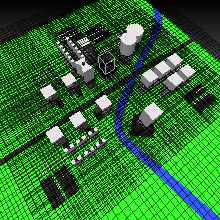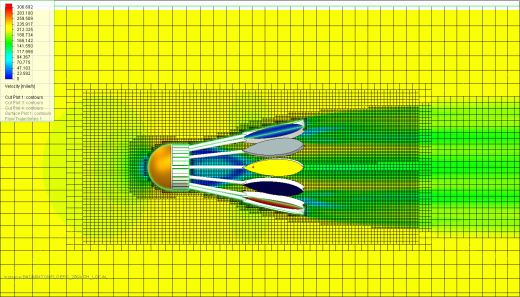“Why Cartesian Grids Are Good”
I put the title in quotes as it’s the title of a blog post by John Chawner at Pointwise who keeps a pleasantly vendor neutral(ish) blog about all things CFD called ‘Another Fine Mesh’, including the excellent weekly ‘This Week in CFD’ that is becoming a bit of a mecca for the CFD community. John’s blog focusses on a white paper Mentor issued recently about How to Choose an Effective Grid System for CFD Meshing. I thought it would be a good opportunity to talk about the motivation and strategy that has resulted in such meshes being central to the technologies of FloTHERM, FloVENT and FloEFD, our flagship CFD tools.

When David Tatchell and Harvey Rosten left CHAM in the late 1980s to start Flomerics they had a vision to provide ‘good science to engineers’, this phrase was even written on the front page of the original Flomerics business case. The choice of the CFD numerics that they deployed in first FloSYS and then in FloTHERM and FloVENT was fully intended. Structured Cartesian mesh with a fully structured solver provided the robustness, stability and low memory footprint that was a pre-requisite for the class of user that they were targeting. Engineers have enough to do as it is when designing product, adding the requirement to understand numerical methods, gridding systems, the subtleties of turbulence modelling, near wall treatments etc. would detract from their primary objective. At most an understanding of fluid dynamics is required to ensure that the model definition is valid and that results can be interpreted correctly.
Wind the clock forward to 2005 and Flomerics were in the market for acquisitions. Despite the possibility of an alternative, NIKA was chosen as the preferred company and the acquisition was completed in July 2006. Started by Roland Feldhinkel in 1999 with a vision of the ‘democratisation of CFD’ (now a somewhat popularist and overused term) via its FloEFD product line, NIKA shared the same philosophies as Flomerics. As was described in the acquisition press release at the time:
“The fundamental philosophy behind FloEFD has a lot in common with that behind the existing Flomerics products, namely delivering complex simulation software in a way that is easily accessible and usable by engineers who are not analysis specialists. Whilst CFD is an established technology which has been used by specialists for many years, the delivery of CFD solutions to broad-based mechanical CAD (MCAD) users in the engineering design community is relatively new.”
Again, it was both by design and no coincidence that FloEFD too was founded on a Cartesian gridding system. A different one albeit using an octree approach for mesh refinement and a novel meshless near wall treatment. With it being fully embedded in numerous MCAD systems FloEFD’s CFD technology had to be robust enough for both the target user as well as the complex (and often ‘unclean’) geometry encountered.

As David Tatchell succinctly described it in his blog – Don’t Mistake “Simple to Use CFD” for “Simple CFD”.
Since the acquisition of Flomerics by Mentor Graphics in 2008 our CFD technology continues to adapt to changing environments. The move towards Windows based systems, 64 bit operating systems and the massive simulation models that are now commonplace, multi core/processor systems that are now standard, all are driving our product roadmaps but we will not be dissuaded from the path that we set out on and a Cartesian approach will underpin our technology going forward.
27th October 2012, Ross-on-Wye


